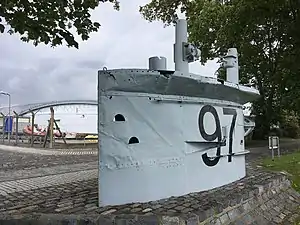 The conning tower of E17 | |
| History | |
|---|---|
| Name | HMS E17 |
| Builder | Vickers, Barrow |
| Laid down | 29 July 1914 |
| Launched | 16 January 1915 |
| Commissioned | 7 April 1915 |
| Fate | Wrecked, 6 January 1916 |
| General characteristics | |
| Class and type | E-class submarine |
| Displacement |
|
| Length | 181 ft (55 m) |
| Beam | 15 ft (4.6 m) |
| Propulsion |
|
| Speed |
|
| Range |
|
| Complement | 31 |
| Armament |
|
HMS E17 was a British E-class submarine built by Vickers, Barrow-in-Furness. She was laid down on 29 July 1914, launched on 16 January 1915 and was commissioned on 7 April 1915. HMS E17 was wrecked off Texel in the North Sea on 6 January 1916. Her crew were rescued by a Dutch cruiser Noordbrabant. They were interned. The conning tower of E17 is preserved as a monument at the Royal Navy Submarine Museum in Gosport, the United Kingdom.[1]
Design
Like all post-E8 British E-class submarines, E17 had a displacement of 662 long tons (673 t) at the surface and 807 long tons (820 t) while submerged. She had a total length of 180 feet (55 m)[2] and a beam of 22 feet 8.5 inches (6.922 m). She was powered by two 800 horsepower (600 kW) Vickers eight-cylinder two-stroke diesel engines and two 420 horsepower (310 kW) electric motors.[3][4] The submarine had a maximum surface speed of 16 knots (30 km/h; 18 mph) and a submerged speed of 10 knots (19 km/h; 12 mph). British E-class submarines had fuel capacities of 50 long tons (51 t) of diesel and ranges of 3,255 miles (5,238 km; 2,829 nmi) when travelling at 10 knots (19 km/h; 12 mph).[2] E17 was capable of operating submerged for five hours when travelling at 5 knots (9.3 km/h; 5.8 mph).
As with most of the early E-class boats, E17 was not fitted with a deck gun during construction, but probably had one fitted later forward of the conning tower. She had five 18-inch (450 mm) torpedo tubes, two in the bow, one either side amidships, and one in the stern; a total of 10 torpedoes were carried.[3]
E-class submarines had wireless systems with 1 kilowatt (1.3 hp) power ratings; in some submarines, these were later upgraded to 3 kilowatts (4.0 hp) systems by removing a midship torpedo tube. Their maximum design depth was 100 feet (30 m) although in service some reached depths of below 200 feet (61 m). Some submarines contained Fessenden oscillator systems.[2]
Her complement was three officers and 28 men.[2]
References
- ↑ Hutchinson, Robert (2001). Jane's submarines : war beneath the waves from 1776 to the present day. London: HarperCollins. ISBN 978-0007105588.
- 1 2 3 4 Innes McCartney; Tony Bryan (20 February 2013). British Submarines of World War I. Osprey Publishing. pp. 11–12. ISBN 978-1-4728-0035-0.
- 1 2 Akerman, P. (1989). Encyclopaedia of British submarines 1901–1955. p.150. Maritime Books. ISBN 1-904381-05-7
- ↑ "E Class". Chatham Submarines. Archived from the original on 13 August 2015. Retrieved 20 August 2015.
External links
- 'Submarine losses 1904 to present day' - Royal Navy Submarine Museum Archived 25 September 2015 at the Wayback Machine